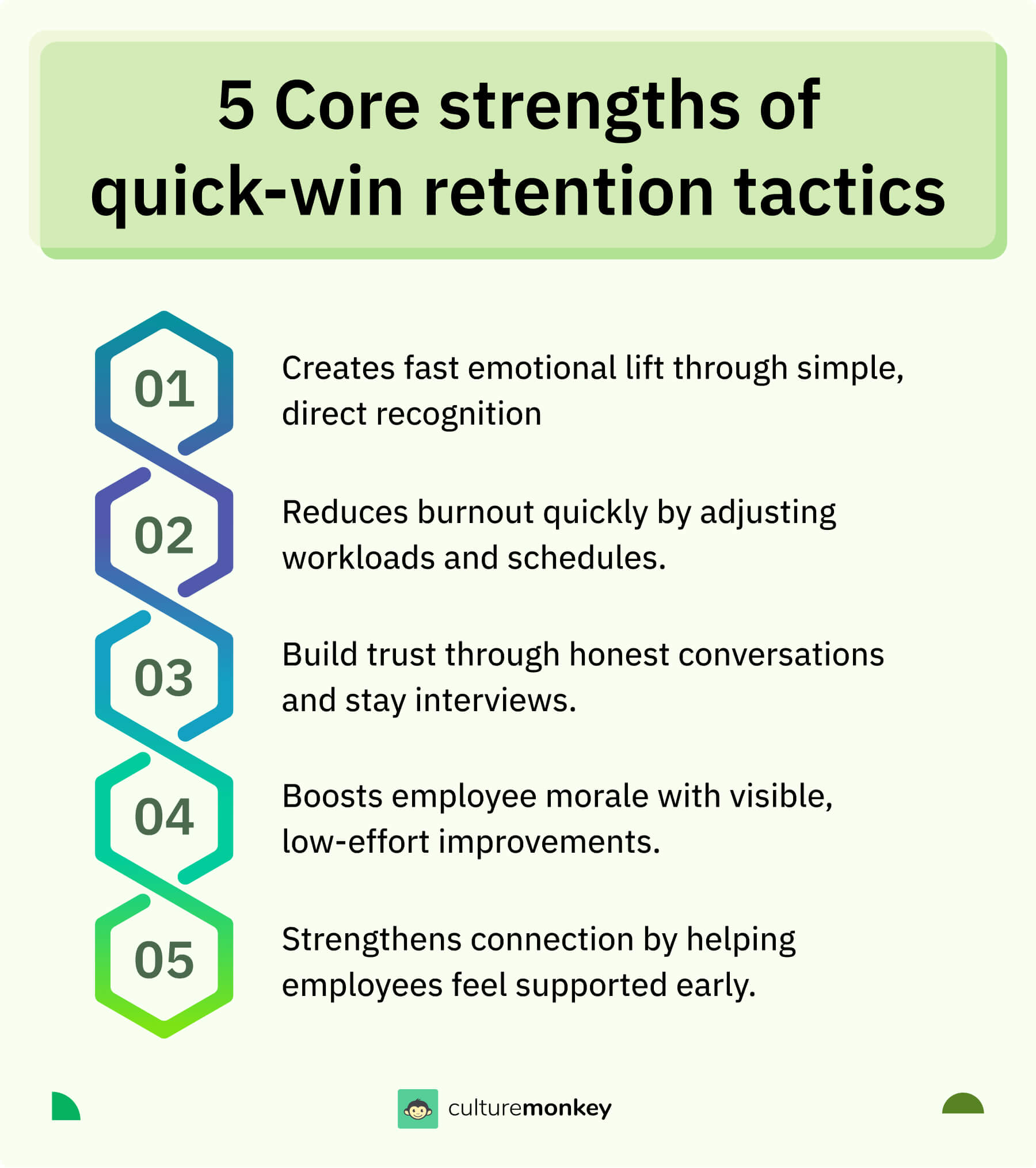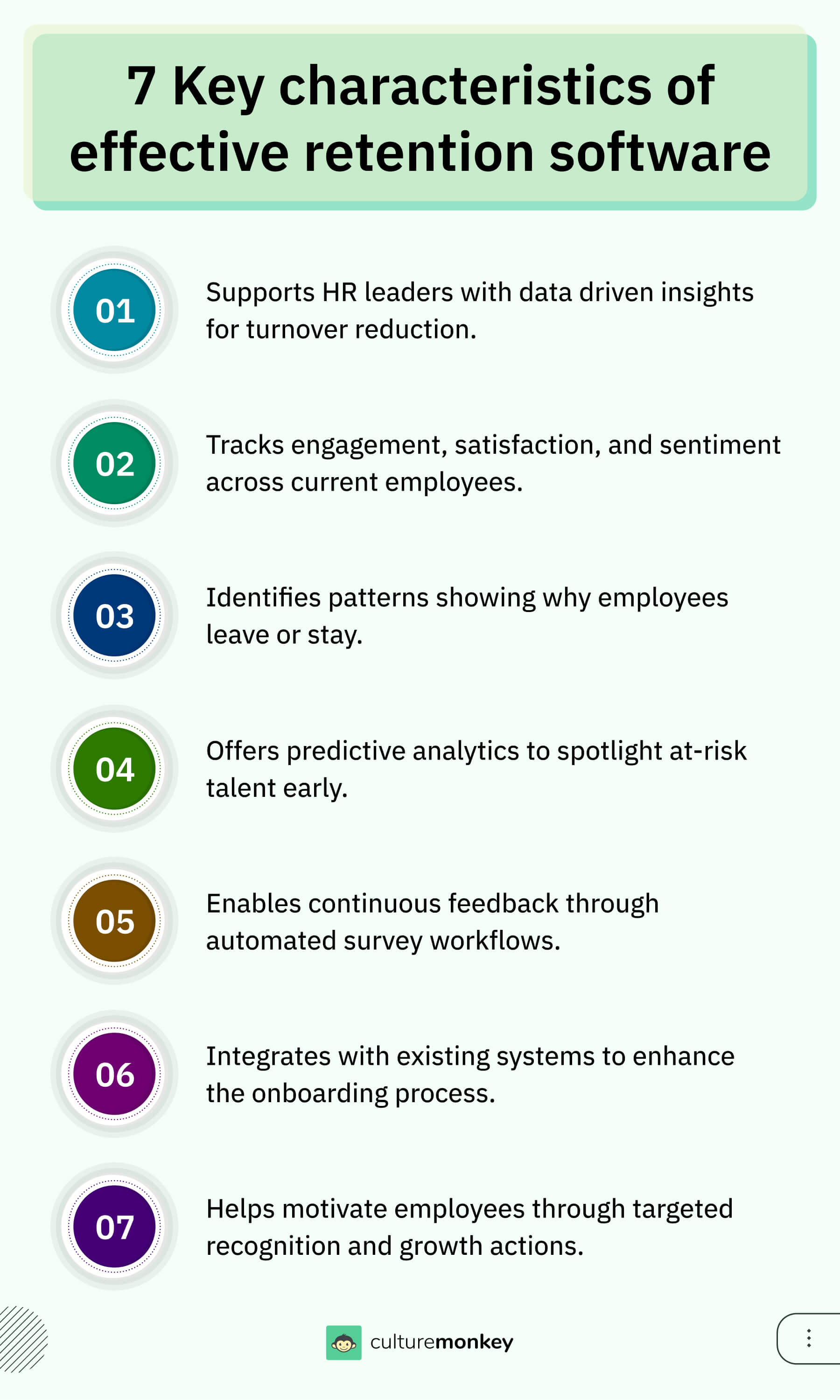20 Employee retention strategies to boost engagement and reduce turnover in 2026

Picture the first car you ever bought that genuinely felt like a milestone. Maybe it was not flashy, but it felt right. You loved how it drove, the little quirks, the comfort of knowing exactly how it responded on the road.
But imagine a few years later: the service center stopped being attentive, the updates slowed, and newer models introduced features that made your old favourite feel a step behind. You did not abandon it suddenly. You just quietly shifted interest because nothing about it was evolving with you.
Employee retention strategies work the same way. People rarely leave because something is broken. They leave when the experience stops progressing. In this guide, we will explore how to build an environment where your top talent keeps choosing you confidently, just like you once chose that car, because staying feels like the smarter long-term decision.
- Employees leave when growth, flexibility, recognition, and manager support decline.
- Quick-win tactics boost morale fast while long-term strategies build stability.
- Clear paths, fair pay, and continuous feedback improve retention.
- Retention software strengthens insight into risks and patterns.
- Strong employee experience reduces turnover and strengthens commitment.
What is employee retention?

Employee retention is an organization’s ability to keep its workforce engaged, satisfied, and committed for the long term, reducing voluntary turnover. It involves strategies that meet employee needs, such as competitive pay, growth opportunities, recognition, and work-life balance, to encourage loyalty and reduce the risk of losing top talent.
For businesses, strong employee retention strategies help maintain stability, protect institutional knowledge, and lower hiring costs. Retention also improves morale, boosts productivity, and strengthens company culture.
By aligning HR retention strategies, staff retention programs, and talent retention methods with employee expectations, organizations create an environment where people choose to stay and grow, driving sustainable business success and long-term workforce resilience.
Why are employees leaving work in 2026

Losing people today is like losing subscribers on a streaming platform. They don’t cancel suddenly. They drift when new content stops showing up, or old content feels stale. The same slow fade happens at work when leaders miss early signals that shape workplace retention strategies and long-term commitment.
- Lack of growth clarity: People leave when development stalls and pathways disappear. Strong strategies for employee retention work better when teams see real future steps, supported by a clear employee retention plan that evolves with them.
- Weak manager support: Poor guidance pushes people out faster than policies do. The effectiveness of employee retention strategies improves when managers get coaching and use simple employee retention ideas consistently in daily conversations.
- Stagnant work experience: Repetitive work reduces motivation. Best retention strategies introduce variety and ownership so people stay curious rather than feeling stuck, especially during fast organisational change.
- Unfair workload pressure: High pressure without support drives early exits. Strong workplace retention strategies address load balance, helping retention strategies for employees feel fair, predictable, and sustainable.
- Lack of flexibility: Many leave when flexibility feels limited. Retention strategies for remote employee experience matter because people want schedules that respect real life without adding stress.
- Poor recognition patterns: When wins go unnoticed, loyalty drops. Employee retention programs that reward meaningful impact help people feel valued and reduce preventable turnover.
- Misaligned pay and benefits: Compensation that feels outdated pushes people to explore options. Updating retention strategy examples around pay keeps teams confident that their effort matches their rewards.
- Culture mismatch: When values feel unclear, people disconnect. Strong employee retention programs reinforce what the organisation stands for, making it easier to stay connected and committed.
Once you understand why employees leave, the next step is applying fast actions that strengthen employee morale and encourage employees to stay.
These quick tactics help support employees, improve employee recognition, and boost employee retention while keeping current employees engaged and connected.
Quick-win tactics for employee retention (30-day impact)

Not all employee retention strategies take months to show results. Some can create noticeable improvements in engagement and loyalty within just 30 days. These quick-win employee retention ideas are ideal for organizations looking to boost morale, strengthen relationships, and address immediate retention risks while longer-term plans are being developed.
Tactics like recognition blitzes, stay interviews, and skill-building micro-sessions show immediate commitment and appreciation.
Balancing workloads, offering flexible work options, and starting peer mentorship programs help reduce burnout and foster belonging, addressing retention risks while longer-term plans develop.
- Launch a recognition blitz: Implement staff retention strategies that publicly celebrate recent achievements through internal channels, team meetings, and social media.
- Conduct stay interviews: Use employee retention tips like one-on-one conversations to understand why they stay and what might tempt them employees' leave.
- Offer skill-building micro-sessions: Skill retention strategies that include short, high-impact training sessions show commitment to growth without overwhelming workloads.
- Review and adjust workloads: Effective employee retention strategies often start with balancing tasks to reduce burnout and frustration.
- Introduce flexible work adjustments: HR retention strategies that allow small schedule changes or remote days can quickly improve work-life balance.
- Pilot a peer mentorship program: Creative retention strategies that connect new employees with current employees through employee resource groups can boost confidence and belonging fast.
20 Effective employee retention strategies in 2026

Designing retention today is like adjusting flight paths mid air. You cannot rely on last year’s routes and expect safe landings in new weather. In 2026, leaders need flexible, data led moves, modern employee retention tactics, and simple everyday habits that steadily keep people choosing to stay on board together.
1. Build role based growth paths
Treat career maps as your core employee retention strategy, giving each role clear milestones and next steps. This helps ambitious people see a future worth investing their time, energy, and loyalty in here.
2. Make managers retention coaches
Train managers on how to improve employee retention using simple rituals like stay interviews and monthly check ins. Focus these conversations on support, not blame, so risks surface early and trust increases steadily across teams.
3. Use always on feedback loops
Combine pulse surveys with targeted listening to spot early churn themes and understand how to increase employee retention. Close the loop by sharing what you heard and which changes you will actually implement.
4. Modernise your rewards mix
Go beyond annual hikes by linking pay, spot bonuses, and benefits to clear outcomes using market data. This keeps rewards feeling fair and transparent, a core part of best employee retention practices in competitive talent markets.
5. Design flexible work playbooks
Create clear guidelines for hybrid and remote setups instead of vague promises or one off exceptions. Treat flexibility as a structured staff retention strategy that balances business needs, team rituals, individual preferences, and manager well-being.
6. Invest in meaningful onboarding
Use structured, cross functional onboarding as one of your worker retention strategies to shape the first 90 days. Focus that time on relationships, clarity, and quick wins that build confidence instead of scattered tasks.
7. Create internal mobility lanes
Build employee retention plans that make moving across teams easier than leaving for a similar role outside. Use transparent criteria, timelines, and manager support so internal applications and stretch assignments feel encouraged, not risky.
8. Run regular stay interviews
Use simple, open conversations to learn why people stay and what might make them leave. Ask which retention initiatives matter most, then feed those insights into your broader talent retention strategies and annual planning cycles.
9. Tie recognition to specific impact
Replace generic praise with detailed appreciation linked to values, behaviours, and outcomes. When done consistently, recognition becomes one of the keys to employee retention instead of a random, feel good exercise people ignore.
10. Strengthen manager communication skills
Offer practical training, prompts, and templates so managers can run clear one to ones and explain decisions. These skills support staff retention techniques during uncertain periods, restructures, or heavy change where rumours otherwise fill the silence.
11. Use employee retention software wisely
Move beyond dashboards by assigning clear owners for follow ups and time bound actions. Build playbooks for common issues and review outcomes monthly so technology actually supports strategies for employee retention instead of gathering dust.
12. Protect focus time and workload
Help teams prioritise, remove low value work, and set realistic deadlines to avoid constant overload. Making sustainable pace a visible norm turns these employee retention tactics into something people feel daily, across projects.
13. Clarify performance and growth expectations
Replace vague role descriptions with clear outcomes, skill levels, and examples of great work. This ensures staff retention strategy efforts do not fail because people are guessing whether they are performing well enough to grow.
14. Support wellbeing with real choices
Offer layered options like counselling, financial planning, quiet spaces, and realistic time off norms. Tracking usage and feedback helps you turn wellbeing into one of your best employee retention practices rather than a generic benefit.
15. Build stronger team belonging
Make space for rituals, peer recognition, and cross-functional projects that build connection within and across teams. These everyday ties reinforce employee retention tactics more effectively than top-down announcements or one-off culture campaigns.
16. Align work with purpose
Help people see how their work connects to customers and strategy using stories, visits, or simple data. This turns meaning into a daily experience and a powerful extension of your overall staff retention strategy.
17. Prioritise fair and transparent decisions
Share the “why” behind choices on promotions, pay, and restructuring, inviting questions where possible. This steady openness builds trust and credibility, because hidden decisions quietly undermine even the strongest employment retention strategies over time.
18. Equip leaders with real-time insight
Give senior leaders clear retention dashboards, heatmaps, and short narratives tied to real actions. This helps them sponsor employee retention programs actively, not reactively, and focus support where risks and opportunities are highest.
19. Co-create solutions with employees
Involve people in designing policies, tools, and workflows through workshops, councils, or pilots. This makes retention initiatives feel relevant and shared instead of something that happens to them without voice or meaningful influence.
20. Review and refresh strategies yearly
Treat your employee retention strategy as a living system rather than a fixed project. Use data, feedback, and business changes to refine employee retention tactics and keep them sharp for the next hiring cycle.

Unlock proven questions to measure engagement and reduce preventable turnover
Download nowAfter choosing the right retention strategies, leaders must implement them with structure and care. Clear communication, the right onboarding process, and flexible work arrangements help employees feel connected while motivating employees through professional development opportunities and recognition that strengthens company culture.
7 Best practices to implement employee retention strategies

Implementing employee retention strategies effectively requires a structured approach that combines feedback, competitive offerings, supportive culture, and strong leadership. These successful employee retention strategies can help ensure long-term success:
Successful retention requires a structured approach—gathering employee feedback, offering competitive pay, fostering a positive culture, and supporting career growth.
Balancing work-life initiatives, recognition programs, and strong leadership ensures employees feel valued and engaged, creating long-term loyalty while reducing costly turnover.
1. Conduct regular employee surveys: Gather feedback consistently to understand needs, concerns, and satisfaction levels. Analyze the data, share results with employees, and create action plans to address key areas for improvement.
2. Offer competitive compensation and benefits: Benchmark salaries and benefits against industry standards, update packages regularly, and clearly communicate their value to employees to attract and retain top talent.
3. Foster a positive workplace culture: Encourage respect, collaboration, and open communication while implementing diversity, equity, and inclusion initiatives. Celebrate achievements to strengthen job satisfaction and a sense of belonging.
4. Provide career development opportunities: Retention strategies in companies should offer training, workshops, mentorship, and clear progression paths to support further education or certifications aligned with employees’ roles.
5. Enhance work-life balance: Promote flexible hours, remote work options, and wellness programs that address physical, mental, and emotional health. Encouraging breaks and vacations to avoid burnout increases the effectiveness of employee retention strategies.
6. Recognize and reward contributions: Implement a recognition program that provides timely, specific appreciation through bonuses, time off, or public acknowledgment tied to company values.
7. Ensure effective leadership and management: Train leaders in communication, empathy, and conflict resolution. Encourage regular one-on-one meetings and hold managers accountable for engagement and retention.
To retain employees effectively, HR professionals need real time insight into employee satisfaction and morale. Pulse surveys reveal how employees feel about support, recognition, and workload, helping companies prevent employee turnover and act quickly before deeper engagement issues develop.
How do pulse surveys track real time employee sentiment?

Tracking sentiment is like checking a car’s dashboard while driving. You do not wait for smoke to know something is off. Pulse surveys give the same constant signals, helping you apply effective employee retention strategies before problems grow.
This sets the stage for smarter decisions that improve employee retention with clarity and speed.
- Spot early shifts: Pulse results show small dips before they turn into real risk, helping you increase employee retention with faster action.
- Reveal everyday friction: Frequent signals highlight small blockers so you can apply innovative employee retention strategies that remove friction quickly.
- Guide focused action: Clear themes help you choose the best employee retention strategies instead of guessing what people need.
- Strengthen manager awareness: Managers see real-time mood patterns and use simple employee retention tips to reduce churn risk.
- Support smarter planning: Leaders use data-backed employee retention tools to design retention strategies for employees based on facts, not assumptions.
- Create consistent feedback loops: Regular check-ins make staff retention strategies easier to refine because conversations stay current.
- Give practical direction: Clear trends offer employee retention ideas that match real needs, making employee retention strategies examples easier to execute.
As organisations scale, manual efforts are not enough to boost employee retention. Employee retention software helps support employees through continuous feedback, recognises trends in employee satisfaction, and gives hr professionals data to motivate employees and strengthen professional development programs.
Significance of employee retention software in helping you with retention at work

Employee retention software equips HR strategies for employee retention with the tools and insights needed to reduce turnover and strengthen workforce stability. Here’s how it supports effective retention strategies:
Employee retention software empowers HR by collecting and analyzing data on engagement, satisfaction, and turnover to uncover patterns and root causes. This insight enables targeted action plans to improve retention.
With predictive analytics, it identifies at-risk employees, allowing proactive interventions like personalized development, mentorship, or bonuses to keep top talent and reduce turnover effectively.
- Collects and analyzes retention data: Gathers information on employee engagement, satisfaction, and turnover from sources like surveys, performance reviews, and exit interviews.
- Identifies turnover patterns and trends: Aggregates data to uncover the root causes of employee departures, enabling targeted improvements.
- Supports targeted retention strategies: Helps HR teams design action plans that address specific issues affecting retention rates.
- Offers predictive analytics capabilities: Uses forecasting models to identify employees at risk of leaving and predict potential turnover.
- Enables proactive retention interventions: Facilitates personalized development plans, mentorship programs, or retention bonuses to retain high-performing talent.
Conclusion
Employee retention strategies are no longer optional. They shape stability, protect knowledge, and help leaders build teams that stay committed through change. When people feel supported, recognised, and given room to grow, they choose to stay longer, which reduces hiring pressure and strengthens overall performance.
The real win comes from treating retention as an ongoing practice rather than a one time fix, because loyalty is built through small, consistent actions that show people their experience matters.
This is where CultureMonkey becomes a strong partner. It gives leaders clear, real time insight into what their teams need, using pulse surveys, engagement analytics, and role based dashboards to reveal early signs of friction.
Instead of guessing, leaders get data they can act on. With automated action flows, intelligent reporting, and employee feedback tools, CultureMonkey makes retention easier, more predictable, and more scalable for growing organisations that want to keep their best people for the long run.
Book a demo with CultureMonkey!
FAQs
1. What is an employee retention strategy?
An employee retention strategy is a structured plan to keep valuable employees engaged, satisfied, and committed to the organization long-term. It combines competitive compensation, career development, recognition, work-life balance, and strong leadership. By addressing employee needs and fostering a positive workplace culture, organizations reduce turnover, increase job satisfaction, retain top talent, and create a motivated workforce that drives consistent business growth and stability over time.
2. What quick tactics boost retention?
Quick-win tactics for boosting retention include recognizing achievements immediately, offering flexible work schedules, conducting stay interviews, providing small perks like learning stipends, and improving communication between managers and teams. These short-term actions build trust, increase job satisfaction and engagement, and show employees they’re valued. While they deliver rapid impact, combining them with long-term retention strategies ensures sustained loyalty and reduced turnover in competitive industries.
3. Which KPIs prove retention success?
Key performance indicators for retention success include employee turnover rate, employee net promoter score, voluntary attrition rate, average employee tenure, engagement scores, and internal promotion rate. Tracking exit interview trends and absenteeism rates also provides insight. Monitoring these KPIs over time reveals whether strategies are working, highlights problem areas, and ensures organizations can adjust proactively to maintain a strong, stable, and satisfied workforce in the long run.
4. Do remote teams need different strategies?
Yes, remote teams benefit from tailored employee retention strategies. These include structured communication routines, virtual recognition programs, clear career growth paths, and technology that supports collaboration. Providing home office stipends, wellness initiatives, and opportunities for social interaction strengthens connection and engagement. By addressing the unique challenges of remote work, organizations improve retention and keep distributed teams motivated, connected, and loyal over the long term.
5. What are the most effective employee retention strategies today?
The most effective employee retention strategies focus on creating a strong employee experience through fair compensation, advancement opportunities, honest communication, and psychological safety. Business leaders and HR leaders invest in leadership skills, and internal mobility so employees feel supported, learn new skills, and build long term customer relationships. These efforts strengthen talent retention and reduce both direct and indirect costs.
6. How can small businesses improve retention without increasing salaries?
Small businesses can improve retention by strengthening psychological safety, offering flexible advancement opportunities, and helping employees gain new skills through career development programs. Team leaders can provide honest communication, supportive feedback, and meaningful recognition. Even without adjusting the compensation package, business leaders can enhance employee experience by improving internal mobility, and reducing indirect costs that come from job hopping and turnover.
7. What makes employees stay long term in an organization?
Employees stay long term when they trust their direct report, feel psychological safety, and see clear advancement opportunities. Many employees value career development programs, internal mobility, and leadership skills that help them progress. When the overall employee experience feels fair, supportive, and growth focused, employees start building deeper customer relationships and stronger commitment, which therefore improves retention across teams.
8. What are the biggest reasons employees leave even when pay is competitive?
Even when pay is competitive, many employees leave because the employee experience lacks advancement opportunities, honest communication, and psychological safety. Employees start seeking a new job when internal mobility stalls or leadership skills are weak. The same survey patterns show workers plan exits when direct report relationships break down or career development feels limited, increasing talent loss and indirect costs.







